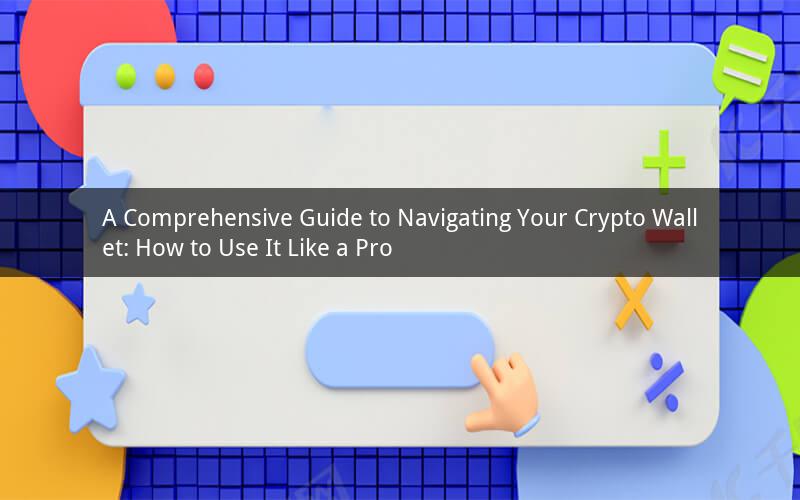
Introduction:
In the rapidly evolving world of cryptocurrencies, managing your digital assets effectively is crucial. A crypto wallet serves as a gateway to your virtual wealth, enabling you to store, send, and receive cryptocurrencies. Whether you're a beginner or an experienced user, this guide will help you understand how to use your crypto wallet efficiently.
Section 1: Understanding Crypto Wallets
1.1 What is a Crypto Wallet?
A crypto wallet is a digital tool that allows users to store, send, and receive cryptocurrencies. It works similarly to a traditional wallet, but instead of holding cash or cards, it stores digital assets.
1.2 Types of Crypto Wallets
1.2.1 Hardware Wallets
Hardware wallets are physical devices that store cryptocurrencies offline, providing enhanced security. They are ideal for large-scale investors and those concerned about security.
1.2.2 Software Wallets
Software wallets are digital applications that can be installed on your computer or smartphone. They are convenient for everyday transactions but may pose a higher risk of hacking.
1.2.3 Mobile Wallets
Mobile wallets are software wallets specifically designed for smartphones. They offer ease of access and are suitable for daily transactions.
1.2.4 Web Wallets
Web wallets are online platforms that allow users to access their cryptocurrencies through a web browser. They are convenient but may have security concerns due to their online nature.
Section 2: Setting Up Your Crypto Wallet
2.1 Choosing the Right Wallet
Before setting up a crypto wallet, research various options and choose one that aligns with your needs, whether it's security, convenience, or cost.
2.2 Creating a Wallet Address
A wallet address is a unique identifier for your crypto wallet. It serves as the destination for receiving cryptocurrencies. To create a wallet address, follow these steps:
a. Open your chosen wallet application or website.
b. Navigate to the "Receive" or "Add Address" section.
c. Generate a new address using the wallet's built-in functionality.
2.3 Securing Your Wallet
Ensure your wallet is secure by following these best practices:
a. Use a strong password or passphrase.
b. Enable two-factor authentication (2FA) if available.
c. Regularly update your wallet software to the latest version.
Section 3: Sending and Receiving Cryptocurrencies
3.1 Sending Cryptocurrencies
To send cryptocurrencies from your wallet, follow these steps:
a. Open your wallet application or website.
b. Navigate to the "Send" or "Transfer" section.
c. Enter the recipient's wallet address.
d. Specify the amount of cryptocurrency you wish to send.
e. Review the transaction details and confirm the transaction.
3.2 Receiving Cryptocurrencies
To receive cryptocurrencies in your wallet, share your wallet address with the sender. The sender can then send the desired amount of cryptocurrency to your address.
Section 4: Best Practices for Using Your Crypto Wallet
4.1 Backup Your Wallet
Regularly backup your wallet to prevent data loss. This ensures that you can restore your wallet in case of hardware failure or loss.
4.2 Keep Your Private Keys Secure
Private keys are the keys to your crypto wallet and should be kept confidential. Never share your private keys with anyone, as they grant access to your digital assets.
4.3 Be Wary of Phishing Attacks
Scammers often attempt to steal private keys or wallet information. Be cautious of phishing emails, fake websites, and suspicious requests for your private keys or wallet details.
4.4 Stay Updated
Keep yourself informed about the latest developments in the cryptocurrency world. This includes staying aware of new features, security vulnerabilities, and regulatory changes.
Section 5: Common Issues and Solutions
5.1 Issue: My wallet is not receiving transactions.
Solution: Verify that you have entered the correct wallet address and ensure the sender has sent the correct amount of cryptocurrency.
5.2 Issue: My wallet is showing a low balance.
Solution: Double-check your transaction history and ensure that the transactions have been confirmed. If not, wait for the network to confirm the transactions.
5.3 Issue: My wallet is frozen or not responding.
Solution: Restart your device or try updating your wallet software. If the issue persists, seek support from the wallet provider or community forums.
5.4 Issue: My private keys have been compromised.
Solution: Immediately change your wallet password and enable two-factor authentication. Report the incident to the wallet provider and consider consulting with a cybersecurity professional.
5.5 Issue: I lost my wallet and cannot access my cryptocurrencies.
Solution: If you have a backup of your wallet, restore it using the backup. If you don't have a backup, contact the wallet provider for assistance or seek help from a professional.
Conclusion:
Using a crypto wallet is an essential step in managing your cryptocurrencies. By understanding the different types of wallets, setting up your wallet securely, and following best practices, you can navigate your crypto wallet like a pro. Remember to stay informed, keep your private keys secure, and seek assistance when needed. Happy crypto journey!
Questions and Answers:
1. Q: Can I use the same wallet for all cryptocurrencies?
A: Yes, some wallets support multiple cryptocurrencies, allowing you to store and manage various digital assets in a single wallet.
2. Q: How can I transfer cryptocurrencies between wallets?
A: To transfer cryptocurrencies between wallets, you need to know the recipient's wallet address and initiate a transfer from your wallet to their address.
3. Q: Can I recover my lost cryptocurrency if I lose my wallet?
A: In most cases, losing your wallet means losing access to your cryptocurrencies. However, if you have a backup or can recover your private keys, you may still be able to access your assets.
4. Q: Are crypto wallets regulated?
A: The regulation of crypto wallets varies by country and jurisdiction. It's important to research and comply with the regulations in your specific region.
5. Q: Can I use a crypto wallet for offline transactions?
A: Yes, some crypto wallets allow you to send and receive cryptocurrencies offline, providing enhanced security for transactions conducted in areas with limited internet connectivity.